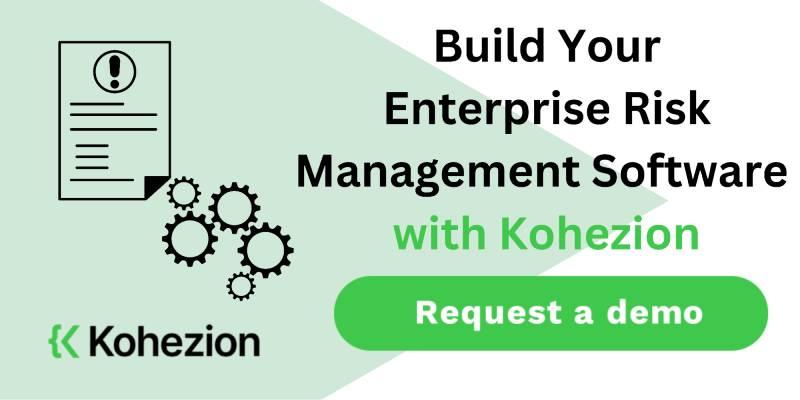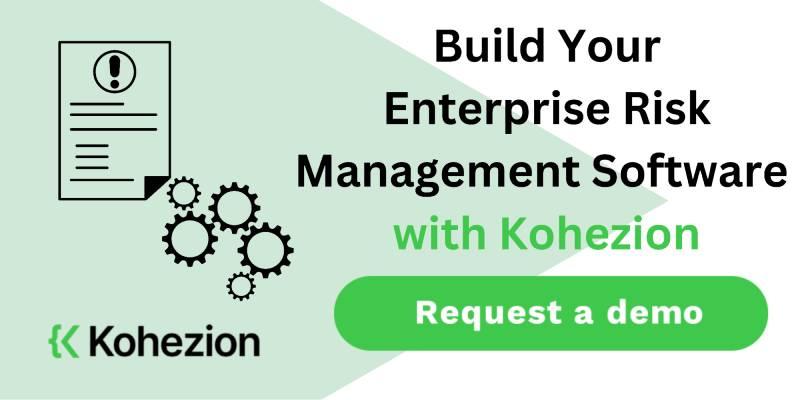More than 80% of executives agree that risk management should encompass all areas of the organization, yet only 36% say they have integrated risk management into their business strategy. This shows the importance of implementing Enterprise Risk Management (ERM) Software, which offers new ways to handle risks.
ERM tools for 2024 will not just spot and reduce risks. They will also make companies more resilient. Given the ever-changing threats out there, the need for good risk management strategies is clear. Top ERM software can bring big benefits, like better decisions and more stakeholder trust.
This article will look at the best ERM tools for 2024 and how they can improve your risk management.
What is Enterprise Risk Management Software
Enterprise Risk Management Software helps identify, assess, and monitor risks. This software is vital for companies to handle risks well and grow safely.
This software helps companies spot and deal with threats that could affect their work. It's made to fit the needs of various industries, giving a full view of the risks a company might face.
Looking into ERM software shows how it helps make better decisions and makes companies stronger. These tools help businesses tackle risks early and stay strong over time.
Why is Enterprise Risk Management Software Important
ERM software is key for companies that want to improve their operations. It helps you spot and handle risks that could stop you from reaching your goals. With this software, you can plan ahead and protect your resources.
Studies show that companies with strong ERM programs face fewer risks and lose less money. Investing in ERM software helps protect assets and make businesses more resilient.
ERM software also makes decision-making easier. It lets you tackle problems early, keeping your business strong through tough times. Adding ERM software to your plans helps your company grow and last longer.

Benefits of Enterprise Risk Management Software
Using ERM software has many benefits for your business. It helps with risk management and makes your organization more efficient, which leads to a stronger business.
Improved Risk Awareness
ERM software makes your team more aware of risks. They can spot and report risks better. This leads to a team that is ready to handle risks.
Increased Efficiency
Technology makes risk management more efficient. Your team can use resources more effectively and avoid wasting time on bad risk plans.
Better Decision-Making
With ERM software, you get insights to make smart choices. This helps you avoid risks and keep your goals in line with risk management.
More Efficient Resource Utilization
ERM solutions help you use resources wisely. They match risk management with your budget, making your organization more efficient and productive.
Improved Regulatory Compliance
Using ERM tools helps people follow the law better, lowering the risk of legal problems and avoiding fines for not following the rules.
Increased Stakeholder Confidence
Showing strong risk management with ERM software builds trust. This trust leads to better partnerships and more investment.
Strengthened Resilience Against Uncertainty
ERM software helps you prepare for risks. This makes your company ready for surprises. It helps you adapt better to new challenges.
Reduced Operational Costs
Good risk management can cut costs from risks. This means your business can make more money and stay financially healthy.
Improved Business Continuity
ERM software helps you plan to keep your business running during tough times. This planning keeps your operations stable and cuts down on downtime.

Top 10 Enterprise Risk Management Tools
Below is a list of the top 10 ERM tools that offer comprehensive features to help businesses improve risk visibility, streamline compliance, and make informed decisions.
1. Kohezion
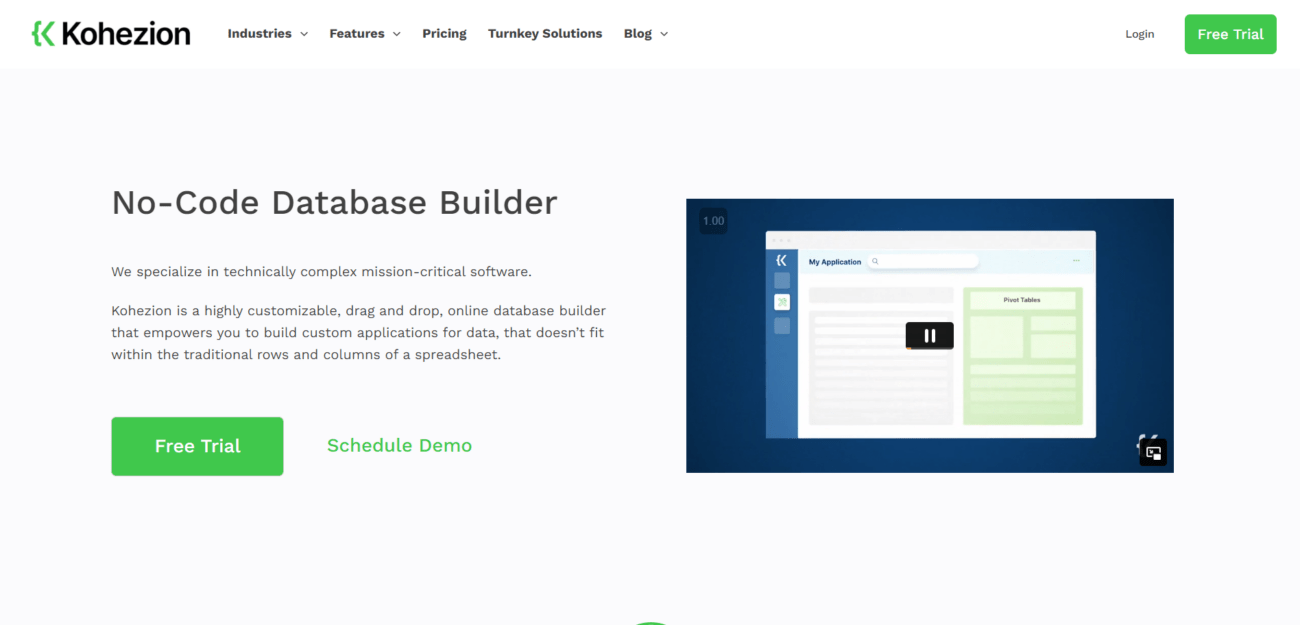
Kohezion is a versatile cloud-based ERM software designed to allow organisations to customize and automate their risk management processes. It offers a user-friendly interface, allowing businesses to create tailored applications that meet their specific needs without coding knowledge. Kohezion supports collaboration and data sharing across teams, ensuring that risk management is integrated into the entire organization's workflow.
Top 5 Features:
- Customizable Applications: Build applications tailored to specific risk management needs without coding.
- Data Visualization Tools: Visualize data with charts and dashboards for better insights.
- User Access Control: Manage user permissions to ensure data security.
- Automated Alerts: Set up alerts to notify users of important updates or changes.
- Integration Capabilities: Integrate with other tools and platforms for seamless data flow.
5 Benefits:
- Increased Flexibility: Customize applications to meet unique business requirements.
- Improved Collaboration: Facilitate better collaboration among teams with shared access to data.
- Increased Efficiency: Automate repetitive tasks to save time and reduce human error.
- Better Risk Visibility: Gain insights into risks through comprehensive data visualization.
- Scalability: Scale applications as the business grows without limitations.
2 Cons:
- Learning Curve: Initial setup and customization can be time-consuming.
- Limited Advanced Features: May lack some advanced features compared to specialized ERM solutions.
Best For:
Small to medium-sized businesses looking for customizable and scalable ERM solutions that require minimal coding knowledge.
2. Standard Fusion
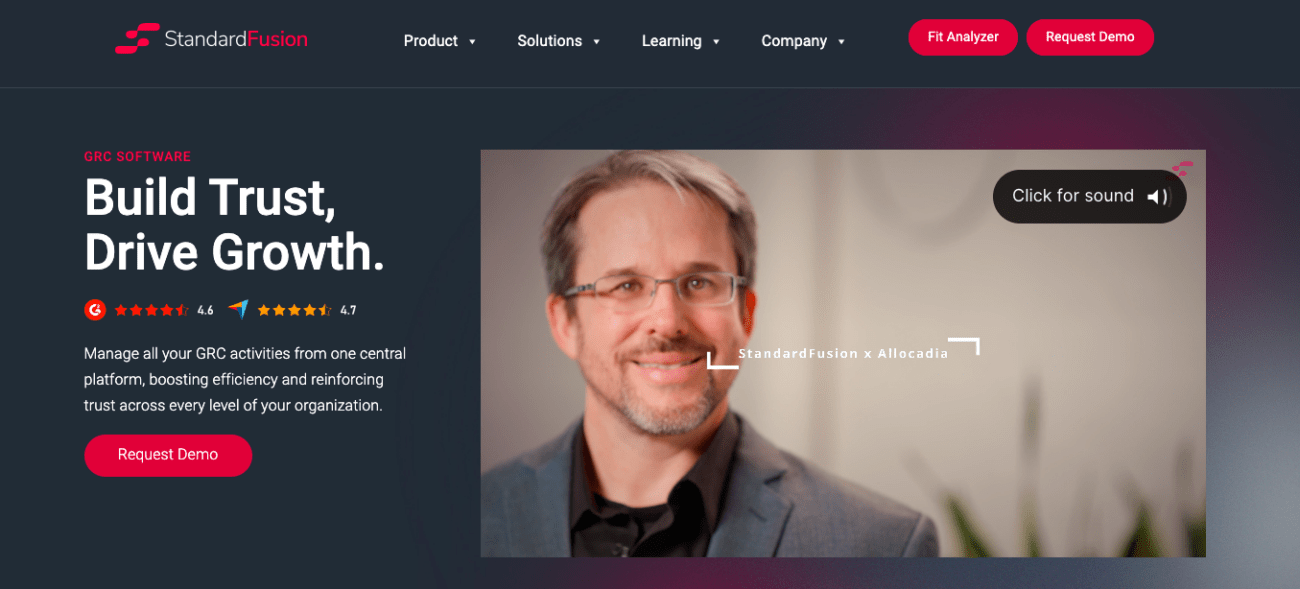
StandardFusion is cloud-based GRC (Governance, Risk, and Compliance) software offering a structured risk management approach. It helps organizations identify, assess, and manage risks while ensuring compliance with industry standards and regulations. The platform is designed for simplicity, making it easy for organizations to integrate risk management into their daily operations.
Top 5 Features:
- Compliance Management: Track compliance with industry standards and regulations.
- Risk Assessment Tools: Assess risks with customizable risk assessment tools.
- Audit Management: Manage audits efficiently with streamlined audit processes.
- Incident Management: Track and respond to incidents in real-time.
- Reporting and Analytics: Generate reports and analyze data for better decision-making.
5 Benefits:
- Streamlined Compliance: Ensure compliance with industry standards effortlessly.
- Comprehensive Risk Assessment: Identify and assess risks accurately with robust tools.
- Efficient Auditing: Simplify audit processes and reduce time spent on audits.
- Real-Time Incident Tracking: Respond quickly to incidents and mitigate risks.
- Data-Driven Decisions: Make informed decisions with data-driven insights.
2 Cons:
- Limited Customization: Customization options may be lacking for specific business needs.
- Higher Cost for Small Businesses: Pricing may be prohibitive for small businesses.
Best For:
Medium to large organizations seeking a comprehensive GRC solution to manage risk and compliance efficiently.
3. Metric Stream
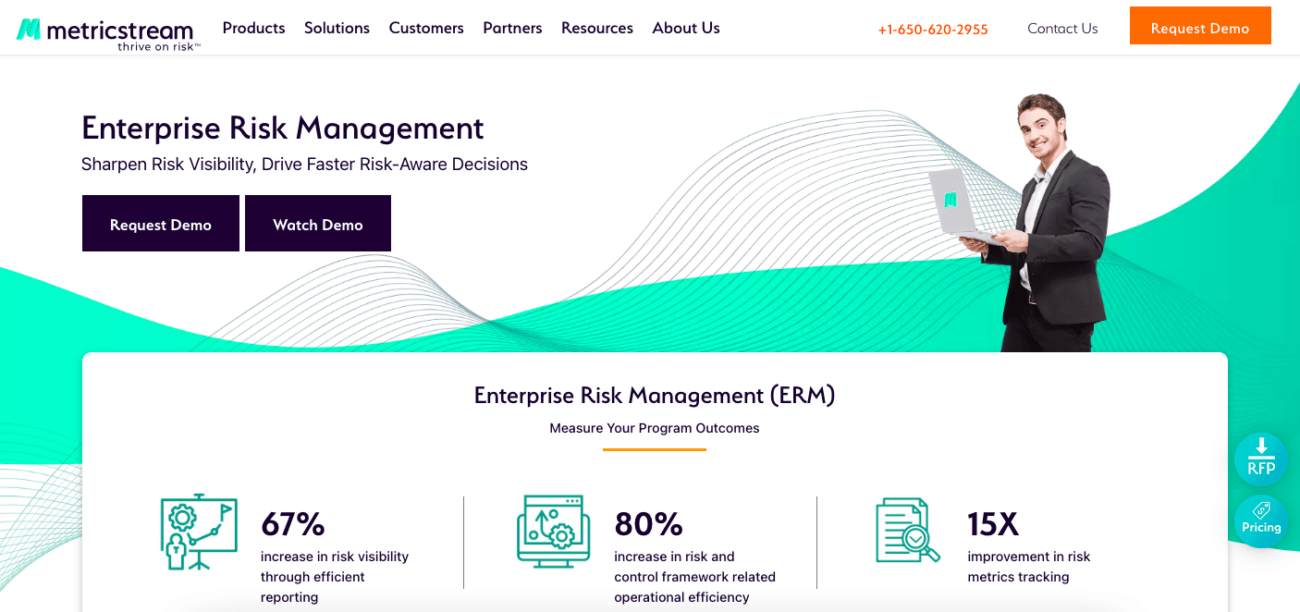
MetricStream is a leading provider of GRC software solutions that help organizations manage risks, compliance, and audits across their enterprise. It offers a wide range of features that provide a holistic view of risk and compliance, enabling organizations to make informed decisions and improve their risk management strategies. MetricStream is known for its robust analytics and reporting capabilities, providing organizations with valuable insights into their risk landscape.
Top 5 Features:
- Integrated Risk Management: Centralized platform for managing risks across the enterprise.
- Compliance Tracking: Monitor compliance with industry regulations and standards.
- Audit Management: Conduct audits with automated workflows and documentation.
- Advanced Analytics: Gain insights into risk data with advanced analytics and reporting.
- Third-Party Risk Management: Assess and manage risks associated with third-party vendors.
5 Benefits:
- Holistic Risk Management: Manage all risks from a single, integrated platform.
- Proactive Compliance Management: Ensure proactive compliance with regulations.
- Improved Decision-Making: Make informed decisions with comprehensive risk insights.
- Efficient Audit Processes: Streamline audits and reduce manual effort.
- Improved Vendor Risk Management: Mitigate risks from third-party vendors effectively.
2 Cons:
- Complex Implementation: Implementation can be complex and time-consuming.
- Higher Price Point: Pricing may be higher than other ERM solutions.
Best For:
Large enterprises seeking a comprehensive and integrated GRC solution for managing risks, compliance, and audits.
4. Synergi Life

Synergi Life, developed by DNV GL, is a comprehensive risk and incident management software that enables organizations to manage risks, incidents, and audits effectively. It provides tools to improve safety and operational efficiency in various industries, including oil and gas, healthcare, and manufacturing. Synergi Life focuses on improving risk visibility and fostering a culture of safety and compliance within organizations.
Top 5 Features:
- Incident Management: Track and manage incidents with detailed reporting tools.
- Risk Assessment: Assess and evaluate risks with customizable risk assessment tools.
- Audit and Inspection Management: Conduct audits and inspections with streamlined workflows.
- Safety Management: Improve safety with tools for managing safety observations and actions.
- Performance Monitoring: Monitor performance and track key metrics for continuous improvement.
5 Benefits:
- Improved Safety Culture: Foster a culture of safety and compliance across the organization.
- Comprehensive Risk Visibility: Gain visibility into risks and incidents with detailed reports.
- Efficient Incident Response: Respond to incidents quickly and reduce risk exposure.
- Streamlined Audits: Simplify audit and inspection processes to save time and resources.
- Continuous Improvement: Monitor performance and implement improvements for better outcomes.
2 Cons:
- Industry-Specific Features: Some features may be tailored to specific industries, limiting applicability to others.
- Complexity: May be complex for smaller organizations without dedicated risk management teams.
Best For:
Organizations in high-risk industries, such as oil and gas or healthcare, seeking comprehensive risk and incident management solutions.
5. Resolver

Resolver is a cloud-based risk management software that provides organizations with tools to identify, assess, and mitigate risks across their operations. It offers a user-friendly interface and customizable features allowing organizations to tailor the platform to their needs. Resolver is designed to support organizations in various industries, including finance, healthcare, and government.
Top 5 Features:
- Risk Assessment Tools: Assess and evaluate risks with customizable risk assessment tools.
- Incident Management: Track and manage incidents with real-time reporting and analysis.
- Audit and Compliance Management: Conduct audits and track compliance with industry standards.
- Risk Analytics: Analyze risk data with advanced analytics and reporting tools.
- Customizable Dashboards: Create dashboards tailored to specific risk management needs.
5 Benefits:
- Improved Risk Visibility: Gain insights into risks across the organization with comprehensive data visualization.
- Improved Decision-Making: Make informed decisions with data-driven insights and analytics.
- Efficient Incident Response: Respond to incidents quickly and mitigate risks effectively.
- Streamlined Compliance: Ensure effortless compliance with industry standards and regulations.
- Customizable Platform: Tailor the platform to meet unique business requirements.
2 Cons:
- Learning Curve: Initial setup and customization may require time and resources.
- Limited Industry-Specific Features: May lack specialized features for certain industries.
Best For:
Medium to large organizations seeking a flexible and customizable risk management solution that can be tailored to their specific needs.
6. OneTrust
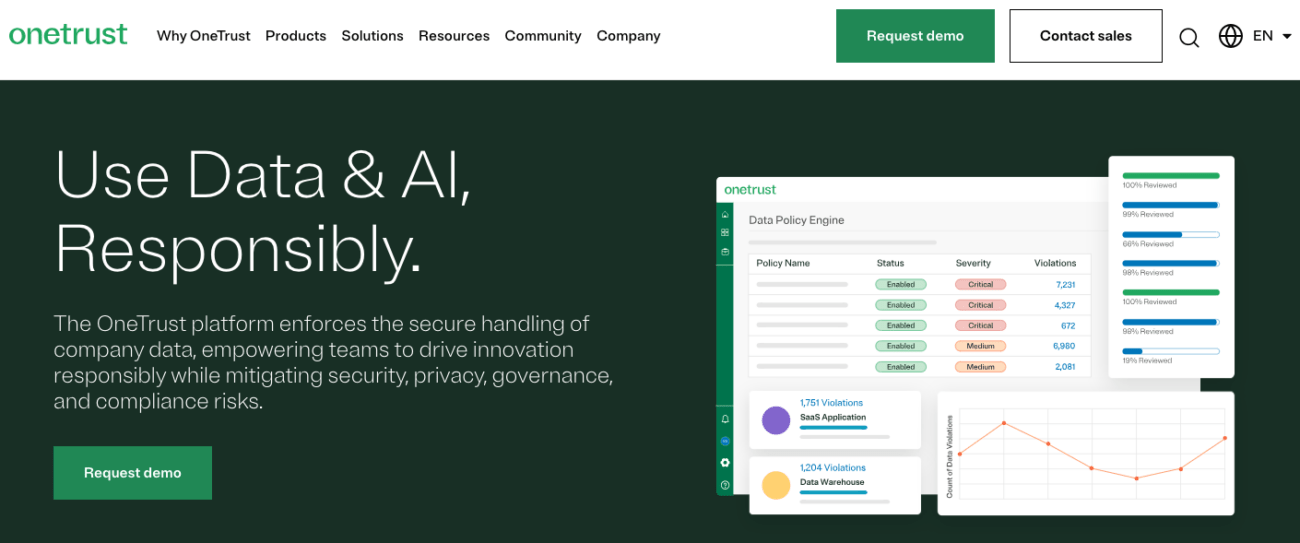
OneTrust is a leading provider of privacy, security, and governance software that helps organizations manage risks related to data privacy and compliance. It offers a comprehensive suite of tools designed to improve data protection, ensure compliance with global privacy regulations, and mitigate risks associated with data breaches. OneTrust is known for its robust privacy management features, making it a popular choice for organizations handling sensitive data.
Top 5 Features:
- Privacy Management: Manage data privacy and compliance with global privacy regulations.
- Data Mapping: Visualize and map data flows across the organization for better data management.
- Incident Management: Track and respond to data breaches and incidents in real-time.
- Third-Party Risk Management: Assess and manage risks associated with third-party vendors.
- Compliance Automation: Automate compliance processes to ensure adherence to regulations.
5 Benefits:
- Improved Data Protection: Protect sensitive data and ensure compliance with privacy regulations.
- Efficient Incident Response: Respond quickly to data breaches and mitigate risks effectively.
- Improved Vendor Management: Assess and manage risks from third-party vendors with ease.
- Streamlined Compliance Processes: Automate compliance processes to save time and resources.
- Comprehensive Data Visibility: Gain insights into data flows and risks across the organization.
2 Cons:
- Complexity: May be complex for smaller organizations without dedicated compliance teams.
- Higher Price Point: Pricing may be higher than other risk management solutions.
Best For:
Organizations handling sensitive data, such as healthcare, finance, and technology companies, seeking robust privacy and compliance management solutions.
7. SpiraPlan

SpiraPlan by Inflectra is an integrated risk management and project management software that provides organizations with tools to manage risks, projects, and resources effectively. It offers features that increase project visibility, streamline processes, and improve decision-making. SpiraPlan is known for its user-friendly interface and robust project management capabilities, making it a popular choice for organizations looking to integrate risk management into their project workflows.
Top 5 Features:
- Project Management: Manage projects with comprehensive project management tools.
- Risk Assessment: Identify and assess risks with customizable risk assessment tools.
- Resource Management: Allocate and manage resources efficiently across projects.
- Reporting and Analytics: Generate reports and analyze data for better decision-making.
- Integration Capabilities: Integrate with other tools and platforms for seamless data flow.
5 Benefits:
- Improved Project Visibility: Gain insights into projects and risks with comprehensive data visualization.
- Efficient Resource Management: Allocate and manage resources effectively across projects.
- Streamlined Processes: Simplify project management and risk assessment processes to save time and resources.
- Improved Decision-Making: Make informed decisions with data-driven insights and analytics.
- Customizable Platform: Tailor the platform to meet unique business requirements.
2 Cons:
- Limited Industry-Specific Features: May lack specialized features for certain industries.
- Learning Curve: Initial setup and customization may require time and resources.
Best For:
Organizations looking to integrate risk management into their project management workflows, especially those in industries with complex project requirements.
8. Essential ERM
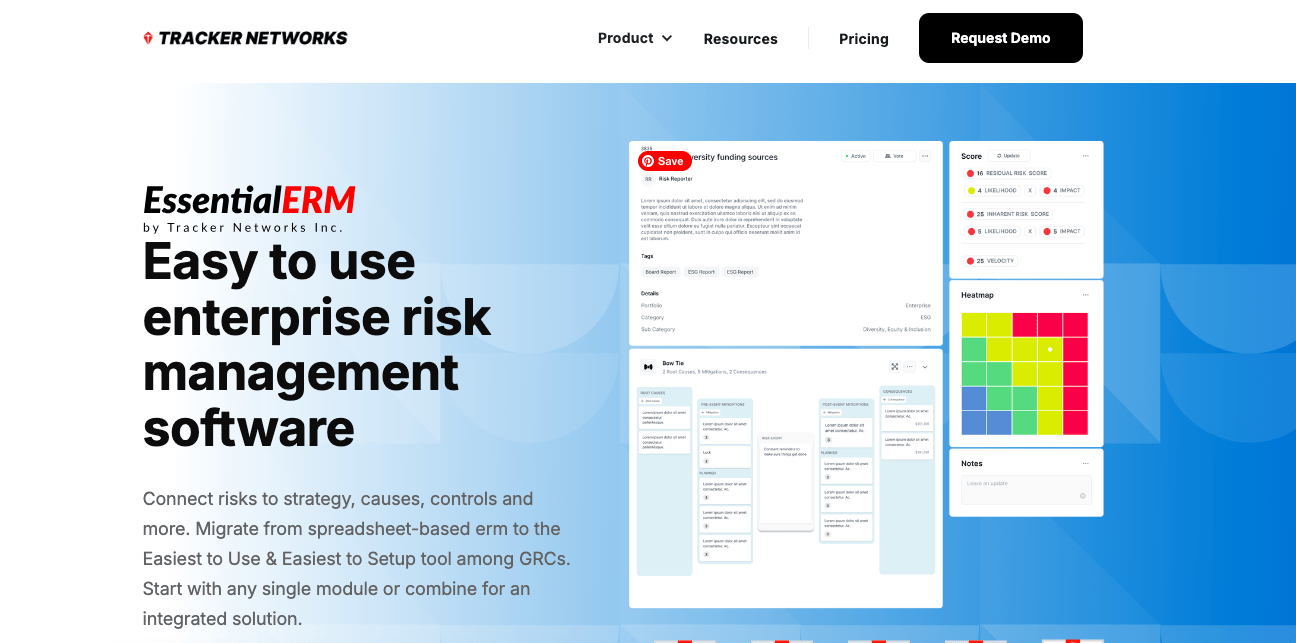
Essential ERM by Tracker Networks is a cloud-based risk management software that provides organizations with tools to identify, assess, and manage risks effectively. It offers a user-friendly interface and customizable features that allow organizations to tailor the platform to their specific needs. Essential ERM is designed to support organizations in various industries.
Top 5 Features:
- Risk Assessment Tools: Assess and evaluate risks with customizable risk assessment tools.
- Incident Management: Track and manage incidents with real-time reporting and analysis.
- Audit and Compliance Management: Conduct audits and track compliance with industry standards.
- Risk Analytics: Analyze risk data with advanced analytics and reporting tools.
- Customizable Dashboards: Create dashboards tailored to specific risk management needs.
5 Benefits:
- Improved Risk Visibility: Gain insights into organisational risks with comprehensive data visualization.
- Improved Decision-Making: Make informed decisions with data-driven insights and analytics.
- Efficient Incident Response: Respond to incidents quickly and mitigate risks effectively.
- Streamlined Compliance: Ensure compliance with industry standards and regulations effortlessly.
- Customizable Platform: Tailor the platform to meet unique business requirements.
2 Cons:
- Learning Curve: Initial setup and customization may require time and resources.
- Limited Industry-Specific Features: May lack specialized features for certain industries.
Best For:
Medium to large organizations seeking a flexible and customizable risk management solution that can be tailored to their specific needs.
9. Camms.Risk

Camms.Risk is an enterprise risk management software designed to help organizations identify, assess, and manage risks effectively. It offers a comprehensive suite of tools for risk management, compliance, and performance management, providing organizations with a holistic view of their risk landscape. Camms.Risk is known for its user-friendly interface and customizable features, making it a popular choice for organizations looking to improve their risk management strategies.
Top 5 Features:
- Risk Assessment Tools: Assess and evaluate risks with customizable risk assessment tools.
- Compliance Management: Track compliance with industry standards and regulations.
- Performance Management: Monitor performance and track key metrics for continuous improvement.
- Incident Management: Track and manage incidents with real-time reporting and analysis.
- Customizable Dashboards: Create dashboards tailored to specific risk management needs.
5 Benefits:
- Improved Risk Visibility: Gain insights into risks across the organization with comprehensive data visualization.
- Improved Decision-Making: Make informed decisions with data-driven insights and analytics.
- Efficient Incident Response: Respond to incidents quickly and mitigate risks effectively.
- Streamlined Compliance: Ensure compliance with industry standards and regulations effortlessly.
- Customizable Platform: Tailor the platform to meet unique business requirements.
2 Cons:
- Learning Curve: Initial setup and customization may require time and resources.
- Limited Industry-Specific Features: May lack specialized features for certain industries.
Best For:
Medium to large organizations seeking a comprehensive and customizable risk management solution that can be tailored to their specific needs.
10. Integrum
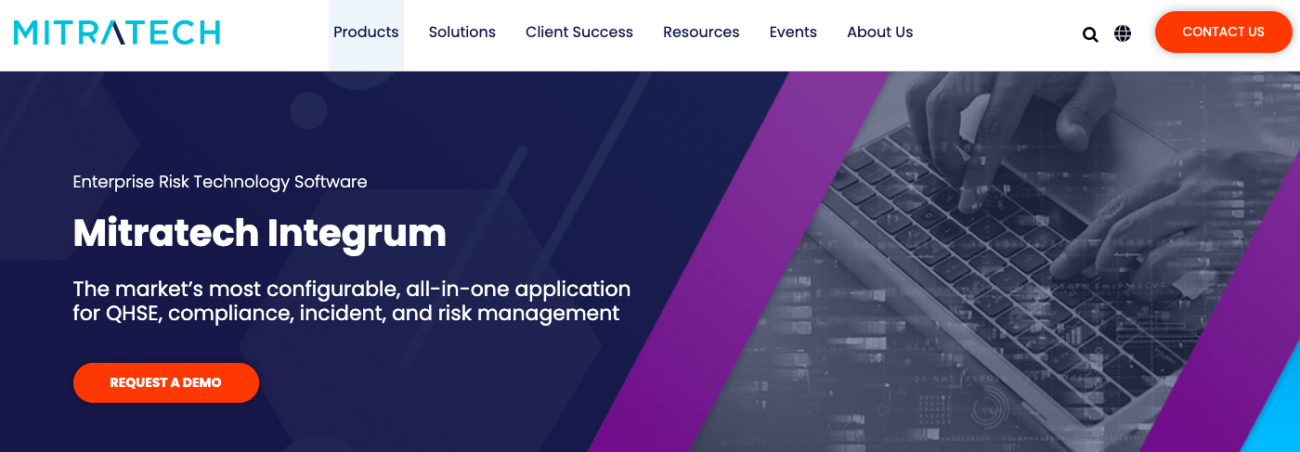
Mitratech’s Integrum is an integrated risk management and compliance software that provides organizations with tools to manage risks, incidents, and audits effectively. It offers a comprehensive suite of features designed to improve isk visibility, streamline processes, and improve decision-making. Integrum is known for its user-friendly interface and robust compliance management capabilities, making it a popular choice for organizations looking to integrate risk management into their compliance workflows.
Top 5 Features:
- Risk Assessment Tools: Assess and evaluate risks with customizable risk assessment tools.
- Incident Management: Track and manage incidents with real-time reporting and analysis.
- Audit and Compliance Management: Conduct audits and track compliance with industry standards.
- Risk Analytics: Analyze risk data with advanced analytics and reporting tools.
- Customizable Dashboards: Create dashboards tailored to specific risk management needs.
5 Benefits:
- Improved Risk Visibility: Gain insights into risks across the organization with comprehensive data visualization.
- Improved Decision-Making: Make informed decisions with data-driven insights and analytics.
- Efficient Incident Response: Respond to incidents quickly and mitigate risks effectively.
- Streamlined Compliance: Ensure compliance with industry standards and regulations effortlessly.
- Customizable Platform: Tailor the platform to meet unique business requirements.
2 Cons:
- Learning Curve: Initial setup and customization may require time and resources.
- Limited Industry-Specific Features: May lack specialized features for certain industries.
Best For:
Medium to large organizations seeking a comprehensive and customizable risk management solution that can be tailored to their specific needs.
Top Features in Enterprise Risk Management Software
Enterprise Risk Management (ERM) software has many key features. These features help manage risks better. They give you the tools you need for good risk assessment and strategies.
Risk Identification and Assessment Features
ERM software has centralized risk repositories for easy risk logging. Tools like heat maps and risk questionnaires help clearly show potential threats.
This makes it easy to see and sort risks according to their impact. This way, you can focus on the most important risks first.
Scenario Analysis and Risk Quantification
These platforms also support scenario analysis and risk quantification. You can simulate risks to explore uncertainties thoroughly. This proactive method helps prevent risks before they happen.
It makes your business more ready for any surprises.
Integration with Strategic Planning
ERM software links risk management with your business goals. Dashboards and analytics tools show how risks affect your main business targets. This ensures risk management is part of your strategy.
Automated Reporting and Analytics
Automated analytics make reporting in ERM systems better. They help create custom reports and dashboards easily. This makes risk data clear and shareable in your company.
This cuts down on manual work and mistakes. It leads to more precise and timely risk information.
Dashboards
Dashboards offer a comprehensive, real-time view of risk metrics, allowing organizations to monitor, analyze, and respond to potential threats effectively, all from a centralized, user-friendly interface.

Common Challenges in Implementing Risk Management Tools
Starting to use risk management tools can be tough for many companies. Knowing the usual problems in ERM can make it easier. These issues often stop risk management frameworks and practices from working well together.
Change Resistance
Many people resist new technologies and ways of doing things in ERM. Getting employees on board and showing them the good parts of risk management tools can ease their worries. This helps them accept the changes better.
Data Quality and Integrity Challenges
Good and consistent data is key for doing risk assessments, but many companies struggle with data quality, which makes risk management hard. Making sure data is reliable is very important for spotting and checking risks.
Ineffective Risk Assessment Processes
Some companies have risk assessment frameworks that don't work well. This leads to not fully covering risks. Making these processes better can really help manage risks more effectively.
Siloed Mindset
When risk management is done in separate parts, it's hard to talk across departments. This makes the whole thing less effective and hurts teamwork. It's important to get everyone in the company to work together for ERM.
Inadequate Reporting and Communication
Good communication is key for sharing risks with everyone in the company. Bad reporting can prevent important information from getting to the right people. Improving how we talk about risks can help fix this.
| Challenge | Description | Impact |
| Change Resistance | Hesitation to adopt new technologies and processes. | Delays in implementation and potential underutilization of tools. |
| Data Quality and Integrity Challenges | Inconsistent data affecting risk assessment accuracy. | Compromised decision-making based on unreliable data. |
| Ineffective Risk Assessment Processes | Frameworks leading to incomplete risk profiles. | Inability to mitigate risks effectively and efficiently. |
| Siloed Mindset | Limited communication between departments. | Reduced effectiveness of risk management. |
| Inadequate Reporting and Communication | Poor transparency regarding organizational risks. | Stakeholders lack awareness and understanding of critical risks. |
The world of Enterprise Risk Management (ERM) is changing fast, thanks to new trends. Keeping up with these changes helps your company manage risks better.
Adoption of Cognitive, Cloud, and Other Innovative Technologies
New tech like innovative risk management technologies is changing ERM. Cognitive computing and cloud solutions make risk management smarter and faster. They help you spot threats early and make better decisions.
Advanced Predictive Analytics
Using advanced predictive analytics is now common in many companies. This trend lets you predict risks better. It helps you act early to reduce risks, making your decisions smarter.
Increased Focus on the Interconnectedness of Risks
Knowing how risks connect and affect each other is key to managing them well. Understanding these connections will help you handle the complex business world better, improving your risk management.
Ongoing Improvements for Resilience
Companies need to keep improving their ERM to stay strong against unknown risks. Adapting to new challenges supports your business's growth and stability.
How Kohezion’s ERM Software Benefits Your Business
Kohezion changes how you handle risk management. It offers a cloud-based platform designed for various risk management needs. This solution helps different departments work together, ensuring a single approach to handling risks.
One key benefit of Kohezion in risk management is its strong features for risk assessment. It lets you spot risks early, making it easier to act quickly. With better reporting and analytics, decision-makers get the insights they need to adapt to changing risks.
Using Kohezion ERM software makes your operations more efficient. Its easy-to-use interface and flexible tools help teams work better together, which increases productivity. Combining data and creating detailed reports helps you tackle current and future challenges confidently.
Conclusion
ERM Software helps your organization stay strong and flexible when facing different risks. Using ERM tools makes decisions easier, increases efficiency, and helps follow rules. The benefits include better risk awareness, more confidence among stakeholders, and lower costs. These advantages help your business deal with the changing risk landscape.
Enterprise Risk Management Software protects your current operations and sets your business up for growth. These tools ensure your company does well in uncertain times and open up chances for success.
Start building with a free account
Frequently Asked Questions
ERM software solutions provide a more comprehensive view of risks across an entire organization, while traditional tools often focus on specific areas. ERM software integrates risk management into all business processes, helping to identify, assess, and manage risks more effectively.
ERM software is used by businesses of all sizes and industries, including healthcare, finance, manufacturing, and technology. Companies with complex operations or those subject to regulatory compliance often rely on ERM solutions to manage their risks effectively.
Yes, small businesses can benefit from ERM software. This software increases risk visibility, improves decision-making, and ensures compliance. It helps them to manage risks more efficiently, which can lead to cost savings and improved business resilience.
Evaluating improved risk awareness, better decision-making processes, increased efficiency, and better alignment of risk management with business goals will help you measure the success of ERM software implementation can be measured. Monitoring key performance indicators (KPIs) and achieving targeted outcomes also indicate success.
The cost of ERM software varies widely based on factors like features, the size of the organization, and the level of customization required. Prices can range from a few thousand dollars annually for small businesses to hundreds of thousands for large enterprises with complex needs.
